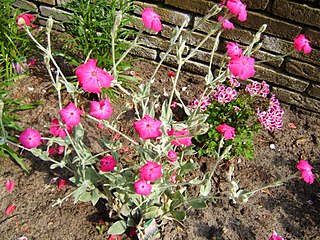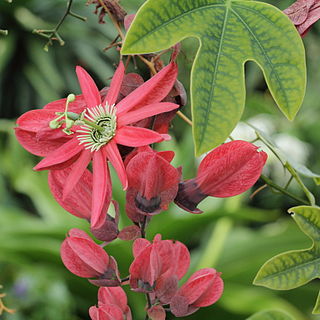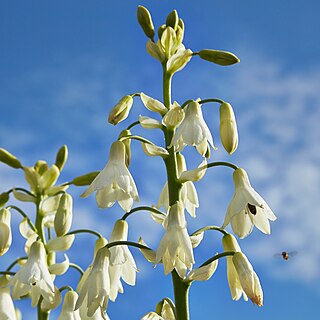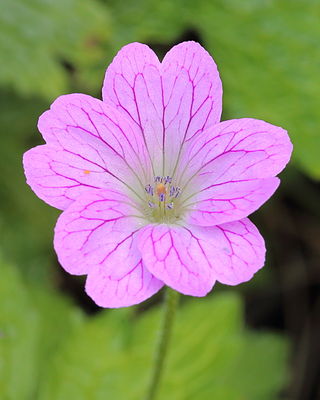Related Research Articles

Geranium cinereum, the ashy cranesbill, is a species of flowering plant in the family Geraniaceae, native to the Pyrenees. Growing to 50 cm (20 in) tall and wide, it is a small, deciduous or semi-evergreen perennial usually grown for low ground cover, rockeries or underplanting larger subjects like roses. Leaves are deeply divided and grey-green – whence the Latin specific epithet cinereum "ash-grey". It flowers in summer, with striking black-eyed flowers with black stamens. The plant grows in full sunlight, and is hardy down to −15 °C (5 °F).

The Royal Horticultural Society (RHS), founded in 1804 as the Horticultural Society of London, is the UK's leading gardening charity.

The RHS Chelsea Flower Show, formally known as the Great Spring Show, is a garden show held for five days in May by the Royal Horticultural Society (RHS) in the grounds of the Royal Hospital Chelsea in Chelsea, London. Held at Chelsea since 1912, the show is attended by members of the British royal family.

Petunia is a genus of 20 species of flowering plants of South American origin. The popular flower of the same name derived its epithet from the French, which took the word pétun, 'tobacco', from a Tupi–Guarani language. A tender perennial, most of the varieties seen in gardens are hybrids.
RHS Britain in Bloom is the largest horticultural campaign in the United Kingdom. It was first held in 1963, initiated by the British Tourist Board based on the example set by Fleurissement de France, which since 1959 has promoted the annual Concours des villes et villages fleuris. It has been organised by the Royal Horticultural Society (RHS) since 2002.

RHS Garden Wisley is a garden run by the Royal Horticultural Society in Wisley, Surrey, south of London. It is one of five gardens run by the society, the others being Harlow Carr, Hyde Hall, Rosemoor, and Bridgewater. Wisley is the second most visited paid entry garden in the United Kingdom after the Royal Botanic Gardens, Kew, with 1,232,772 visitors in 2019.

Camellia japonica, known as common camellia, or Japanese camellia, is a species of Camellia, a flowering plant genus in the family Theaceae. There are thousands of cultivars of C. japonica in cultivation, with many colors and forms of flowers. In the U.S. it is sometimes called japonica. In the wild, it is found in mainland China, Taiwan, southern Korea and southwestern Japan. It grows in forests, at altitudes of around 300–1,100 metres (980–3,600 ft).

The Award of Garden Merit (AGM) is a long-established annual award for plants by the British Royal Horticultural Society (RHS). It is based on assessment of the plants' performance under UK growing conditions.

Silene coronaria, the rose campion, is a species of flowering plant in the family Caryophyllaceae, native to Asia and Europe. Other common names include dusty miller, mullein-pink and bloody William. In the United Kingdom it is still widely referenced under its synonym Lychnis coronaria.

Malva trimestris, common names annual mallow, rose mallow, royal mallow, regal mallow, and common annual tree mallow is a species of flowering plant native to the Mediterranean region.

Phlox subulata the creeping phlox, moss phlox, moss pink or mountain phlox, is a species of flowering plant in the family Polemoniaceae, native to eastern and central USA, and widely cultivated.

Eryngium giganteum, with the common name Miss Willmott's ghost, is a species of flowering plant in the family Apiaceae.

Begonia grandis, the hardy begonia, is a species of flowering plant in the family Begoniaceae. This herbaceous perennial has alternate, simple leaves on arching stems. The flowers are pink or white, borne in dichotomously branching cymes from late summer through fall in USDA U.S. Hardiness Zone 7. As the common name "hardy begonia" implies, it is winter hardy in some temperate regions.

Paeonia peregrina is a species of flowering plant in the peony family Paeoniaceae, native to Southeastern Europe and Turkey. It is an erect, herbaceous perennial with 9-lobed, deeply divided leaves. Single, glossy red flowers, 10–13 cm (4–5 in) in diameter, with prominent yellow stamens, are borne in spring.

Buddleja colvilei is endemic to the eastern Himalaya; discovered by Hooker in 1849, he declared it 'the handsomest of all Himalayan shrubs.' In 1896 the species was awarded the RHS First Class Certificate (FCC), given to plants 'of outstanding excellence for exhibition'.

Passiflora racemosa, the red passion flower, is a species of flowering plant in the family Passifloraceae, native to Brazil. It is an evergreen climber growing to 5 m (16 ft), with simple or 3-lobed leaves to 10 cm (4 in) long, and vivid red flowers borne in summer. The flowers are 12 cm (5 in) in diameter, with purple and white coronas. They are followed by oblong green fruits.

Ornithogalum candicans, known as the summer hyacinth, is a species of flowering plant in the family Asparagaceae, native to moist grassland in South Africa. It is a bulbous perennial growing to 100–120 cm (39–47 in), with strap-shaped leaves and white snowdrop-like flowers in late summer. It is still widely referenced under its synonym Galtonia candicans. Originally it had been designated as Hyacinthus candicans, by Baker in 1870.

Rosa 'Arthur Bell',, is a yellow rose cultivar, bred by Sam McGredy IV in Northern Ireland in 1964. The rose has won numerous awards, and is popular in England and Northern Europe.

Dryopteris wallichiana, the alpine wood fern, is a robust species of deciduous or semi-evergreen fern in the family Dryopteridaceae, native to the Himalayas, Hawaii, Mexico and Jamaica. It grows to 90 cm (35 in) tall, occasionally 180 cm (71 in) by 75 cm (30 in) wide, with pale green tripinnate fronds, strongly contrasting with the dark brown ribs.

Geranium × oxonianum, the Oxford geranium, is a hybrid variety of flowering plant in the family Geraniaceae, which is a 1932 cross of garden origin between Geranium endressii and Geranium versicolor. Growing to 0.5 m (1.6 ft) tall by 1 m (3.3 ft), it is a highly variable plant with round palmate leaves and often veined flowers in various shades of pink. It can be invasive.
References
- RHS Plant Finder 2005-2006, Dorling Kindersley (2005) ISBN 1-4053-0736-6